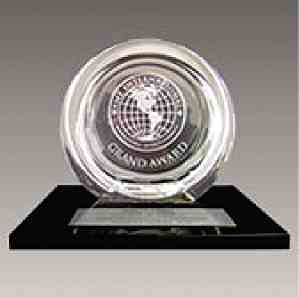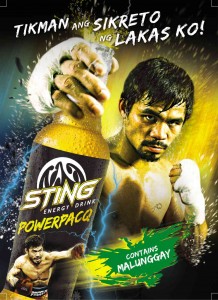Your ad is creative but is it effective?
Your ad is effective but does it display breakthrough marketing plan inventiveness?
At the prestigious AME (Advertising and Marketing Effectiveness) Awards in New York last week, the Philippines won gold for the first time for an ad created by DDB Philippines.
The agency’s entry “Pacquiao Positive” for PepsiCo Philippines’ Sting Energy Power Pacq Drink bested entries from 27 countries. The ad used Manny Pacquiao as celebrity endorser.
Previously, it won two golds in “Tinta Awards” and a bronze in Spikes Asia.
“It is a testament to our hardwork because we believe in creativity that sells,” says Gil Chua, DDB Group chair and CEO.
Chua credits his hardworking team for the landmark achievement: Joey Ong, Executive Creative Director; Vina Henson, Client Services Director; Denise Banatin, Account Supervisor; Jackie Caruyan, Account Manager; Patrick Miciano, Mon Pineda, Cardy Santos, Associate Creative Directors; Denise Nicole Oyog, Copywriter; Kelvin Co, Art Director; Eric Salazar, Creative Director, Gomer Barce, Art Director.
McCann Worldgroup Philippines also bagged a silver and three bronzes—all for its Coke corporate “OFW Project” and TBWA-Santiago, Mangada and Puno brought home two bronzes for its Energizer and Boysen campaigns.
AME came into the picture in 1994 understanding that there is more to just making an ad and winning an award for creativity’s sake.
It has become the ad and marketing industry’s Oscars after it was founded, honoring work from around the globe that demonstrates groundbreaking solutions to challenging marketing problems.
Unique awards show
Unlike ordinary global advertising award shows, submissions in AME require the following: Entries must address a challenge in the marketplace, utilize outstanding creative elements, incorporate a thorough marketing plan to deliver a successful execution, exhibit specific marketing goals and objectives accomplished through creative execution and strategic planning.
The Grand Jury is comprised of top interactive and multidisciplinary marketers, media planners, strategy directors, social media experts, and creative directors from all over the world.
The first two rounds of judging is divided by regions, (North America, Latin America, Europe, Middle East & Africa, and Asia Pacific), allowing each entry to be reviewed in its social, economic, and cultural context to determine the shortlist and medal winners.
The Grand AME Award also went to another DDB agency—DDB Tribal, Germany.
A total of 27 countries submitted entries for brands including CNN International, Volkswagen, DuPont, Intel, Bench, and Cornetto, among others.
This year, a robust number of entries were entered using celebrity interaction, interactive consumer participation, promotions, environment and cause-theme marketing.
Celebrity-focused campaigns propelled multiple entries to the medal round, punctuating once more that they work effectively in bringing sales.
Lady Gaga, Karl Lagerfeld, Sir Richard Branson, local stars Piolo Pascual and Coco Martin, Christopher Lloyd, Terry Crewes, Ashton Kutcher and British comics Stephen Fry and Jimmy Carr were some of the celebrity endorsers in the entries.
Entries in the Social Benefit categories concentrated on brand initiatives that contributed to the greater good including green-themed “The Donation Army” by Ogilvy Germany for OroVerde Rainforest Foundation; Heimat Werbeagentur GmbH’s “CNN Ecosphere”; and TBWA\Santiago Mangada Puno’s campaign “KNOxOUT Project: EDSA” for Boysen Knoxout.
The United States had 15 shortlisted entries; the Philippines with 9; Hong Kong 7; England 5; Canada, and France each with 4; China and Sweden each with 2; and Denmark, Egypt, Japan, Malaysia, and UAE were each recognized with 1.
Effective ads
Ads are very expensive. It’s worth paying a professional ad agency with a great creative team to avoid waste of money.
Here’s a few tips on how to make them rise above the clutter:
Be single-minded. De-clutter and focus on one proposition (key message). Avoid repetitive, meaningless phrases that make you redundant
Execute your message in an unexpected manner. Craftmanship is key. Be a wordsmith. Catchy lines make ads memorable
There are no hard and fast rules in using short or long copy to explain your product. As long as you give it a kickass art direction, it will fly.
Use the power of imagery to deliver your message. Make it high definition if possible. Remember, a great picture speaks a thousand words
Don’t beat around the bush. Focus on what makes you distinct from other similar products and say why. Give compelling reasons why consumers would believe you.
Be original. Don’t be a clone. Don’t parrot what competition is already doing.
Don’t over-explain that you sound like a broken record.
Be definitive on who you are talking to. Don’t talk down that you may offend. Talk real based on consumer insights.
Plan weeks ahead and know when and where your targets are most receptive to your ad campaign.
Make sure all things mentioned above take effect today and the rest will follow.
Recent changes in the advertising landscape have given a new definition to the word “effective” however.
“Effective” now means bombarding each ad with hard sell messages, the heavier product freights are, the more they think the ad would sell.
The word also dictates that creators of ads use big price bubbles to catch attention.
Sadly, it is not the case. The ad becomes cluttered, full of dizzying elements, suffocated by words and images that defy balance.
Eager to convince their target, the focus dissipates. With too many things filling up the ad from top to bottom, it is bound to produce neither well-intended goals.
Studies have shown that clutter in ads reduces effectiveness, insults the viewer and degrades brands. Is the consumer too dumb he doesn’t get it?
According to a survey made by Burst Media in the US, nearly 30 percent will refuse to read a cluttered ad and immediately turn to the next page of a newspaper if they see one.
It’s also true in digital media. Just as there are well-produced ads, there are also those that you don’t even bother to look at when you’re browsing.
The same number of respondents say they will leave a website if they perceive it to be cluttered with ads. More than 75 percent of those who remain on cluttered sites will also pay less attention to the ads unless they are entertaining and make sense.
It is not hard to spot a cluttered ad.
“We see ads on newspapers everyday, saying too many things they compete with the news themselves,” says a marketing director known for his top-selling brands.
Some even camouflage a newspaper’s persona just to get attention. Some even make it appear that it is a section of a favorite broadsheet.
He advises admakers to sound real when they do an ad. “Be inventive, don’t write an ad like you lifted the messages straight out of strategy document of a manufacturer,” he says.
The Burst Media survey reveals further:
“Content clutter hurts the reputation of parties that produce them. The way an ad is produced has an impact on consumers’ perceptions of an advertiser’s products and services.”
Half of all respondents surveyed had less favorable opinion of advertisers that produced cluttered advertising and placed them on cluttered media.
“A cluttered ad is a waste of client’s money. Take a closer look and sweep unnecessary communication debris off them,” a 4A’s director says.

